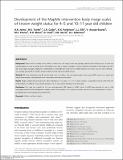Files in this item
Development of the MapMe intervention body image scales of known weight status for 4-5 and 10-11 year old children
Item metadata
| dc.contributor.author | Jones, A | |
| dc.contributor.author | Tovee, Martin | |
| dc.contributor.author | Cutler, L | |
| dc.contributor.author | Parkinson, K | |
| dc.contributor.author | Ells, L | |
| dc.contributor.author | Araujo-Soares, V | |
| dc.contributor.author | Pearce, M | |
| dc.contributor.author | Mann, K | |
| dc.contributor.author | Scott, D | |
| dc.contributor.author | Harris, Julie | |
| dc.contributor.author | Adamson, Ashley | |
| dc.date.accessioned | 2017-11-29T11:30:20Z | |
| dc.date.available | 2017-11-29T11:30:20Z | |
| dc.date.issued | 2018-09-01 | |
| dc.identifier | 251495100 | |
| dc.identifier | e6041bb8-de47-459f-967c-bb370feded53 | |
| dc.identifier | 85054068627 | |
| dc.identifier | 000456085500045 | |
| dc.identifier.citation | Jones , A , Tovee , M , Cutler , L , Parkinson , K , Ells , L , Araujo-Soares , V , Pearce , M , Mann , K , Scott , D , Harris , J & Adamson , A 2018 , ' Development of the MapMe intervention body image scales of known weight status for 4-5 and 10-11 year old children ' , Journal of Public Health , vol. 40 , no. 3 , pp. 582-590 . https://doi.org/10.1093/pubmed/fdx129 | en |
| dc.identifier.issn | 1741-3842 | |
| dc.identifier.other | ORCID: /0000-0002-3497-4503/work/46085853 | |
| dc.identifier.uri | https://hdl.handle.net/10023/12188 | |
| dc.description | This work was supported by the National Prevention Research Initiative [grant number MR/J00054X/1] (incorporating funding from Alzheimer’s Research UK; Alzheimer’s Society; Biotechnology and Biological Sciences Research Council; British Heart Foundation; Cancer Research UK; Chief Scientist Office, Scottish Government Health Directorate; Department of Health; Diabetes UK; Economic and Social Research Council; Engineering and Physical Sciences Research Council; Health and Social Care Research Division, Public Health Agency, Northern Ireland; Medical Research Council; Stroke Association; Wellcome Trust and World Cancer Research Fund). | en |
| dc.description.abstract | Background: Parents tend to visually assess children to determine their weight status and typically underestimate child body size. A visual tool may aid parents to more accurately assess child weight status and so support strategies to reduce childhood overweight. Body image scales (BIS) are visual images of people ranging from underweight to overweight but none exist for children based on UK criteria. Our aim was to develop sex- and age-specific BIS for children, based on British growth reference (UK90) criteria. Methods: BIS were developed using 3D surface body scans of children, their associated weight status using UK90 criteria from height and weight measurements, and qualitative work with parents and health professionals. Results: Height, weight and 3D body scans were collected (211 4-5 years; 177 10-11 years). 12 qualitative sessions were held with 37 participants. Four BIS (4-5 year old girls and boys, 10-11 year old girls and boys) were developed. Conclusions: This study has created the first sex- and age-specific BIS, based on UK90 criteria. The BIS have potential for use in child overweight prevention and management strategies, and in future research. This study also provides a protocol for the development of further BIS appropriate to other age groups and ethnicities. | |
| dc.format.extent | 9 | |
| dc.format.extent | 743855 | |
| dc.language.iso | eng | |
| dc.relation.ispartof | Journal of Public Health | en |
| dc.subject | Children | en |
| dc.subject | Methods | en |
| dc.subject | Obesity | en |
| dc.subject | BF Psychology | en |
| dc.subject | RA0421 Public health. Hygiene. Preventive Medicine | en |
| dc.subject | NDAS | en |
| dc.subject | SDG 3 - Good Health and Well-being | en |
| dc.subject.lcc | BF | en |
| dc.subject.lcc | RA0421 | en |
| dc.title | Development of the MapMe intervention body image scales of known weight status for 4-5 and 10-11 year old children | en |
| dc.type | Journal article | en |
| dc.contributor.sponsor | Medical Research Council | en |
| dc.contributor.institution | University of St Andrews. School of Psychology and Neuroscience | en |
| dc.contributor.institution | University of St Andrews. Institute of Behavioural and Neural Sciences | en |
| dc.identifier.doi | https://doi.org/10.1093/pubmed/fdx129 | |
| dc.description.status | Peer reviewed | en |
| dc.identifier.url | https://academic.oup.com/jpubhealth/article/40/3/582/4668752 | en |
| dc.identifier.grantnumber | en |
This item appears in the following Collection(s)
Items in the St Andrews Research Repository are protected by copyright, with all rights reserved, unless otherwise indicated.

